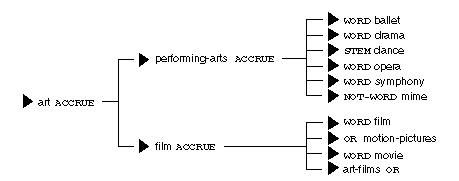A topic is simply a grouping of information related to a concept, or a subject area. A knowledge base is a grouping of these concepts called topics. Combining topics into a knowledge base provides users with the ability to look up concepts saved as topics in a convenient fashion.
The subject area of a topic is typically identified by the topic’s name. In the example below, the subject of the topic is performing-arts. This topic is composed of two structural elements, its name, performing-arts, and its evidence topics, ballet, musical, dance, opera, symphony, and drama.
Operators and modifiers act as the glue that joins related evidence topics. Operators represent logic to be applied to evidence topics. This logic defines the qualifications of the kinds of documents you want to find. Modifiers apply further logic to evidence topics. For example, a modifier can specify that documents containing an evidence topic not be included in the list of results.

A topic’s structure becomes more sophisticated as topics are added to it. In the next example, the topic film has been added to the structure to form what is now the top-level topic, art. In this structure, performing-arts and film are subtopics of the topic art.

Sophisticated topics are composed of top-level topics, subtopics, and evidence topics. These elements determine the related subject areas of a topic. Typically, a knowledge base consists of several top-level topics. Note that subtopics and evidence topics can be used by multiple top-level topics.